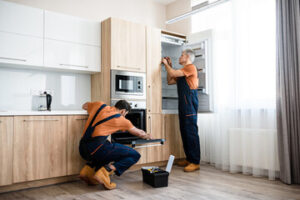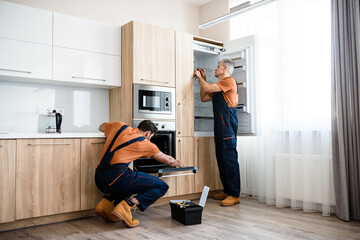Cabinet installation is a complex task that can be time-consuming and frustrating. It is important to know how to properly install cabinets to avoid making mistakes that can cause problems down the line.
Before starting, take the time to mark studs and strike cabinet lines on the wall. Also, mark any ‘in the wall’ piping that you will not want to screw into. Contact Thompson & Boys LLC experts to save you time and money.
 Layout
Layout
Cabinet installation requires a great deal of careful planning. The most important step of the process is “layout,” which refers to the fine-tuning process that ties together vertical and horizontal planes so that your cabinets can hang square, plumb, and level. During layout, you will mark protruding points on the wall and floor using a laser level, tape measure, and pencil. This is done to ensure that your cabinets will be installed on studs, which provide strength and support.
Start by marking a level reference line on the wall for the top of your base cabinets. This will usually be 34-1/2 inches high (or higher with the addition of a countertop). Next, find the highest point on the floor and mark it on the wall. You may need to use a ladder or stool to reach this spot.
Once you know where the top of your base cabinets will be, you can start measuring for the location of your upper cabinetry. Standard wall cabinets are 18 to 20 inches high, but you may want a different height based on your personal preferences or the size of appliances you plan to install in the room. If you’re installing upper cabinets that will meet your ceiling, mark a level line at 19.5 inches from the base cabinet layout line for the bottom of the uppers.
Before starting to install the cabinets, make sure you have the right tools and supplies for the job. A hammer, tape, and pencil are good to have on hand, as well as a ladder or stool for working at heights above ground. You should also have a stud finder to locate the studs in the wall and drill 2-inch screws into them.
You should also set up a ledger board or cabinet jack along the wall at the height where you’re installing your upper cabinets. This will help you keep the cabinetry stable while you’re shimming* it to get it perfectly level.
Once you have a ledger board or cabinet jack in place, set up the first upper cabinet and screw it to the wall. Using the stud marks you made earlier, line up the pilot holes on the back of the cabinet with the corresponding studs in the wall and drive 2-inch screws into them. Repeat this process for each of the upper cabinets until you’ve covered the entire wall.
Wall Studs
Before starting to install cabinets, it is important to check that the wall is stable and level. Using a 4-foot level, check different areas of the installation area and note any dips or angles that need to be shimmed. This ensures that the cabinets will be level and stable once installed.
Next, you will need to locate the wall studs. This can be done by using a stud finder or simply knocking on the wall with your knuckles to listen for differences in sound. The studs will make a much deeper sound than the drywall. Once the studs are located, mark their locations with a pencil on the wall. It is essential to have at least one stud in every cabinet location to ensure the cabinets are secured and will not fall over time.
Once the studs have been located, a ledger board or cleat should be installed to support the cabinets and ensure that they are secure. The cleat or ledger board should be attached to the studs with 2-inch screws. Once the cleat or ledger board is in place, the cabinets can then be mounted to it.
It is also a good idea to add a bead of liquid nails to the plywood panels that are going to be screwed to the wall to help prevent them from pulling away from the studs over time. If you are mounting heavy or tall cabinets, I would suggest adding additional support to the walls in the form of a horizontal metal plate (similar to a stiffener) for extra stability.
If you are installing a combination of upper and lower cabinets, I recommend that you start with the lower cabinets and install them first. This will keep them out of the way and allow you to double-check that your layout is working before you move on to the uppers.
Then, when it comes to installing the upper cabinets, I recommend that you use a stud finder to locate the studs. Once the studs are located, carefully mark them with a pencil on the wall and use a carpenter’s level to ensure that the lines you have drawn on the wall are level.
Clamping
Cabinets need to be properly clamped so they can be securely attached to the wall. Incorrectly clamping cabinets can result in them shifting or falling off of the wall, which is not a good thing! It’s important to know which type of clamp you need and how much pressure to apply. Too little won’t keep the pieces firmly in place, and too much can damage them by leaving marks on the wood.
The best kind of clamp for cabinet face frames is a C-clamp. These are sturdy enough to hold the entire face frame, but they don’t have as much flex as a standard hand screw clamp which could leave marks on your work.
After the face frame is tightly clamped, a level should be used to draw a straight line on the wall at the height where both upper and lower cabinet runs will meet (for example, next to the stove). This is important because it ensures that the cabinets are the same height throughout the room and will be able to support the weight of your countertops when installed.
Once the line is drawn, use a stud finder to locate and mark the studs underneath that location. Then, attach a 1×3 cleat or ledger board to the studs beneath that line and drive 2-inch screws through it. Attach another cleat or ledger board across the whole length of your cabinet run if necessary.
When you’re ready to attach the first cabinet, carefully center it over the cleats or ledger boards and then screw it to the wall using a 2 1/2-inch drywall screw. Then, repeat the process with each of the other cabinets. Be sure to pre-drill each hole before attaching it to avoid splitting the face frame.
Be careful when installing cabinets, especially around gas or electric lines. Always wear proper protective gear, such as a dust mask and steel-toe shoes. Also, make sure to have a spot to set your tools and materials before you begin so that you don’t lose anything or get dirty. With accurate measurements, careful positioning, and secure mounting techniques, cabinets can be an easy DIY project for any homeowner.
Filler Strips
Cabinet filler strips are used to conceal gaps between the wall and cabinets. They can be found in the form of wood blocks, ready for paint, or primed and painted at most home improvement stores. You can also find them online and they are an essential tool for any homeowner, builder, or remodeler to have.
Before you start installing cabinets, it’s important to properly lay out the cabinet layout. The layout does not refer to the general arrangement of the cabinets as they will appear on the finished walls, it’s a fine-tuning process that ties together vertical and horizontal planes so that the cabinets can hang square, plumb, and level. It also helps to determine if there is any existing in-the-wall or through-wall piping, venting, plumbing, or electrical that will impact the cabinet installation.
The first step is to locate and mark every stud location on the wall using a stud finder. This will allow you to easily place the cabinets and avoid screwing into any obstacles in the future.
Once you’ve marked all the studs, it’s time to measure and mark where you want the cabinet wall and floor to meet. This will help you know how long to cut your filler strip and what size to make it. You should use a miter saw to cut the strip a little wider than the largest measurement you made earlier and then sand it with a belt sander until it is flush with the cabinet frame.
When you are ready to install the cabinet, clamp the strip in place and drill pilot holes into the wall and partway into the strip using wood screws. You should countersink the screw heads so that they don’t protrude from the cabinet face when you are finished.
Before you start installing your cabinets, it’s a good idea to test all the hardware on a piece of scrap material or a board in your shop. This will save you a lot of frustration down the road when you’re trying to put together an entire kitchen on-site. If you’re unsure about how to install an item, ask your local cabinet retailer for guidance before you get started.

